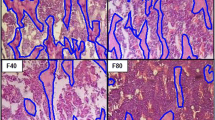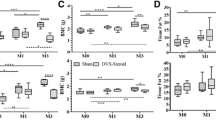Abstract
In 44 osteoporotic subjects who had been treated with fluoride for 37±16 months, the fluoride was discontinued because they had shown fluoride-dependent increases in trabecular spinal bone densities from low initial levels (below the fracture threshold) to values that were equivalent to normal peak bone densities in the spines of young adults. During the subsequent period, after discontinuation of the fluoride therapy (i.e. 19±9 months), spinal bone density decreased in 73% of the subjects (i.e. 32 of 44,p<0.03), at a rate that was comparable to the rate of the previous gain that had occurred during the treatment with fluoride (i.e. −3.23±2.39 mg/cm3 per month, compared with +3.91±1.96 mg/cm3 per month in this subgroup of patients,p<0.001). Although 9 of the 44 subjects showed continuing increases in spinal bone density after discontinuation of the fluoride therapy, spinal bone density decreased in the entire group of 44 at an average rate of −1.02±4.72 mg/cm3 per month (p<0.001, compared with the rate of the previous gain during the treatment with fluoride; i.e. +3.83±1.82 mg/cm3 per month). Surprisingly, our data showed that the rate of decrease in spinal bone density during the post-fluoride period was not affected by concurrent (undesigned) treatment with calcium, calcium plus estrogen, or calcium plus calcitriol. The cessation of fluoride therapy was also associated with a decrease in serum alkaline phosphatase activity (i.e. a decrease from the elevated levels that were observed during the period of fluoride therapy, back to the original, pre-treatment levels;p<0.001), and that the rate of spinal bone loss after cessation of fluoride could be correlated with the prior rate of increase in serum alkaline phosphatase activity that had occurred during the treatment with fluoride (n=44,r=0.312,p=0.039). Together, the observations from this retrospective analysis of data obtained from our clinical subjects suggest that fluoride-treated osteoporotic subjects who have exhibited increases in trabecular spinal bone density are at risk for bone loss after discontinuation of the fluoride therapy.
Similar content being viewed by others
References
Jowsey J, Riggs BL, Kelly PJ, Hoffman DL. Effect of combined therapy with sodium fluoride, vitamin D, and calcium in osteoporosis. Am J Med 1972;53:43–59.
Riggs BL, Hodgson SF, Hoffman DL, et al. Treatment of primary osteoporosis with fluoride and calcium: clinical tolerance and fracture occurrence. JAMA 1980;243:446–9.
Briancon D, Meunier PJ. Treatment of osteoporosis with fluoride, calcium and vitamin D. Ortho Clin of North Am 1981;12:629–48.
Farley SM, Schulz EE, Libanati CR, Baylink DJ. A successful strategy for the use of fluoride therapy for osteoporosis in terms of efficacy and side effects. J Bone Miner Res 1986;1 (Suppll):263.
Hansson T, Roos B. The effect of fluoride and calcium on spinal bone mineral content: a controlled prospective (3 years) study. Calcif Tissue Int 1987;40:315–7.
Farley SM, Libanati CR, Odvina CV, Smith L, et al. Efficacy of long-term fluoride and calcium therapy in correcting the deficit of spinal bone density in osteoporosis. J Clin Epidemiol 1989;42:1067–74.
Pak YC, Khashayar S, Zerwekh JE, et al. Safe and effective treatment of osteoporosis with intermittent released sodium fluoride: augmentation of vertebral bone mass and inhibition of fractures. J Clin Endocrinol Metab 1989;68:150–8.
Farley SM, Wergedal JE, Farley JR, Javier GN, Schulz EE, Talbot JR, et al. Spinal fractures during fluoride therapy for osteoporosis: relationship to spinal bone density. Osteoporosis Int 1992;2:213–8.
Riggs BL, Hodgson SF, O'Fallon WM, Chao EYS, Wahner HW, Muhs JM, et al. Effect of fluoride treatment on the fracture rate in postmenopausal women with osteoporosis. N Engl J Med 1990;322:802–9.
Riggs BL, O'Fallon WM, Lane A, Hodgson SF, Wahner HW, Muhs J, et al. Clinical trial of fluoride therapy in posmenopausal osteoporotic women: extended observations and additional analysis. J Bone Miner Res 1994;9:265–75.
Kleerekiper M, Peterson EL, Nelson DA, Phillips E, Schork MA, Tilley BC, Parfitt AM. A randomized trial of sodium fluoride as a treatment for postmenopausal osteoporosis. Osteoporosis Int 1991;1:155–61.
Odvina CV, Wergedal JR, Libanati CR, Schulz EE, Baylink DJ. Relationship between trabecular body density and fractures: a quantitative definition of spinal osteoporosis. Metabolism 1988;37:221–8.
Cann CE, Genant HK. Precise measurement of vertebral mineral content using computed tomography. J Comput Assisted Tomogr 1980;4:493–500.
Van Straalen JP, Sanders E, Prummel MF, Santers GTB. Bone alkaline phosphatase as indicator of bone formation. Clin Chim Acta 1991;201:27–34.
Farley J, Baylink DJ. Skeletal alkaline phosphatase activity as a bone formation index in vitro. Metabolism 1986;35:563–71.
Charles P, Poser JW, Mosekilde L, et al. Estimation of bone turnover evaluated by47Ca-kinetics: efficiency of serum bone gamma-carboxyglutamic acid containing protein, serum alkaline phosphatase, and urinary hydroxyproline excretion. J Clin Invest 1985;76:2254–9.
Lauffenburger T, Olah AJ, Dambacher J, Guncaga J, Lentner C, Haas H. Bone remodeling and calcium metabolism: a correlated histomorphometric, calcium kinetic, and biochemical study in patients with osteoporosis and Paget's disease. Metabolism 1977;26:589–97.
Mori S, Jee WSS, Li XJ. Production of new trabecular bone in osteoporotic ovariectomized rats by prostaglandin E-2. Calcif Tissue Int 1992;50:80–7.
Ueda K, Saito A, Nakano H, Aoshima M, Yokota M, Moraoka R, Iwaya T. Cortical hyperostosis following long-term administration of prostaglandin E-2 in infants with cyanotic congenital heart disease. J Pediatr 1980;97:834–66.
Ke HZ, Li XJ, Jee WSS. Partial loss of anabolic effect of prostaglandin E2 on bone after its withdrawal in rats. Bone 1991;12:173–83.
Tang LY, Jee WSS, Ke HZ, Kimmel DB. Restoring and maintaining bone in the osteopenic female rat skeleton. I. Changes in bone mass and structure. J Bone Miner Res 1992;7:1093–104.
Gunness-Hey M, Hock JM. Loss of the anabolic effect of parathyroid hormone on bone after discontinuation of hormone in rats. Bone 1989;10:447–52.
Sakhaee K, Heard-Sakhaee MA, Boyd P, Pak CY. Maintenance of spinal bone density after withdrawal of fluoride therapy. J Bone Miner Res 1994;9(Suppl 1):B158.
Author information
Authors and Affiliations
Rights and permissions
About this article
Cite this article
Talbot, J.R., Fischer, M.M., Farley, S.M. et al. The increase in spinal bone density that occurs in response to fluoride therapy for osteoporosis is not maintained after the therapy is discontinued. Osteoporosis Int 6, 442–447 (1996). https://doi.org/10.1007/BF01629576
Received:
Accepted:
Issue Date:
DOI: https://doi.org/10.1007/BF01629576




